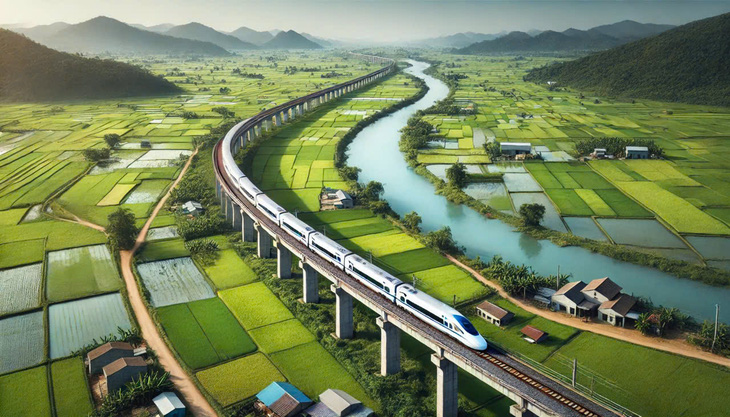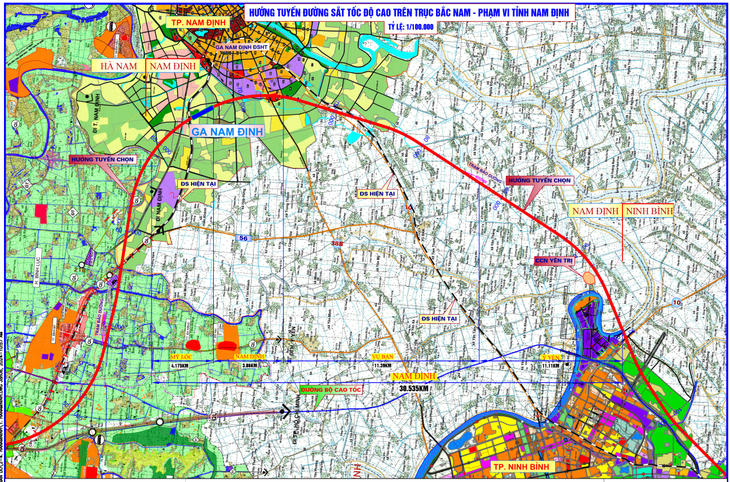In the latest report to the National Assembly for decision on the investment policy of the high-speed railway project on the North-South axis, the Government has explained many contents of the preliminary verification opinion of the Economic Committee of the National Assembly.
The North-South high-speed railway will design and operate passenger trains of 320km/h, freight trains of 120km/h – Illustration: Chat GPT created
How does the 350km/h high-speed railway carry both passengers and goods?
In the report on the investment policy of the high-speed railway project on the North-South axis submitted to the National Assembly on November 10, the Government absorbed and explained the conclusions of the National Assembly Standing Committee, absorbed and explained the preliminary verification report of the Economic Committee on this project.
The Government still maintains the same scale of investment in the construction of a new high-speed railway on the North-South axis, which is a double track, gauge 1,435mm, electric, gas, design speed of 350km/h, load of 22.5 tons/axis; the length of the main route is about 1,541km with 23 passenger stations, 5 freight stations; transporting passengers, meeting dual-use requirements for national defense and security, being able to transport goods when necessary.
With the opinion that there is currently no railway in the world designed with a speed of 350km/h, operated together with freight trains, it is necessary to assess the feasibility and risk level of this option, the Government said:
In practice, in the world, passenger ships designed with a speed of 350km/h have been operated together with cargo ships such as: Barcelona – Perpignan route (Spain – France) is about 175.5km long, operated in 2013, passenger ship design speed is 350km/h, operation is 310km/h, cargo ship design speed is 160km/h.
China has put into operation a freight train running on a railway line with a design speed of 350km/h to transport light, high-value goods and e-commerce goods, intertwined with passenger trains.
The high-speed railway project on the North-South axis determines the design speed of passenger trains of 350km/h (maximum operating speed of 320km/h), freight trains of 160km/h (operating 120km/h). The consultant used a curve radius of 6,500m and calculated according to European standards showing that safe mining conditions were met.
High-speed rail loop to Nam Dinh achieves higher benefits than going straight
With the direction of the high-speed railway route through Nam Dinh city instead of going directly from Ha Nam to Ninh Binh, the Government said that in the process of research, it has come up with 3 options to analyze and compare options: the station is 5km from the city center; the station is 12km from the city center; the route goes directly from Ha Nam to Ninh Binh, not through Nam Dinh.
Direction of the North-South high-speed railway through Nam Dinh – Source: TEDI – TRICC – TEDISOUTH
However, Nam Dinh city has a planned population of about 600,000 people by 2040, is the southern center of the Northern coastal region, is a traffic hub with Thai Binh, Hung Yen provinces, etc. with about 4 million people.
It is forecasted that by 2050, the demand to and from Nam Dinh station will be about nearly 3 million passengers/year. If the cost of investment and operation in 30 years of the route through Nam Dinh (12km city center wing) is about 1.66 billion USD, while the benefits obtained are estimated at 2.06 billion USD.
Thus, the exploitation of the high-speed railway through Nam Dinh city has an estimated benefit of about 400 million USD within 30 years, compared to the direct route without passing through this area.
Experience in Japan, Korea, China… There is also a high-speed rail line that goes around major hubs to attract passengers instead of going straight.
Regarding the ticket price of the North-South high-speed railway, the Government said that it is expected to be about 60-70% of the average air ticket price of the 2 airlines with the largest market share, Vietnam Airlines and Vietjet.
The ticket price will be divided into 3 levels. Expected: first class ticket 0.187 USD/km (VIP cabin); the second tier is 0.078 USD/km; the third place is 0.047 USD/km. Thus, with the Hanoi – Ho Chi Minh City route. Ho Chi Minh City is expected to have a first-class ticket of 7.34 million VND; second-class tickets are 3.05 million VND; the third-class ticket is 1.83 million VND.
Currently, the Hanoi – Ho Chi Minh City route. Ho Chi Minh City, the railway has ticket rates of 1.5 million VND, 1.4 million VND and 960,000 VND; bus ticket 1.1 million VND.
Thereby, the Government believes that the above-mentioned high-speed rail ticket prices are basically reasonable, lower than air, higher than road and with high service quality, time-saving, safer and more comfortable, so it creates attractiveness for people.
The current North-South railway continues to be renovated to carry goods
With the suggestion to make an overall assessment of the investment in completing both the high-speed railway system and the existing railway to have an appropriate basis for investment decision, the Government said that the process of studying the railway development plan on the North-South corridor has considered many scenarios.
On the basis of forecasting transport demand, the current status of the infrastructure system on the North-South corridor, the potential and advantages of modes and referring to international experience, the study has proposed a scenario of building a new railway line with a speed of 350km/h to carry passengers, meet the requirements of dual-use for national defense and security, can carry goods when necessary.
The existing railway line will be renovated and upgraded to meet the needs of freight transportation and tourists with suitable distances.
From 2015 to now, about 1.2 billion USD has been gradually allocated to renovate and improve capacity through the current North-South railway such as: upgrading bridges, tunnels, stations; upgrading the Hoa Duyet – Thanh Luyen area, tunneling through Khe Net Pass. From now to 2030, it will continue to be renovated and upgraded to meet the transportation demand on the route by 2050 (about 18.2 million tons/year).
It is expected that the use of electric energy or clean fuel for existing railways will be decided depending on the efficiency of investment, technology and infrastructure in the period 2030-2035.


